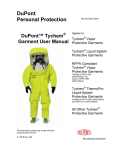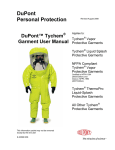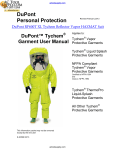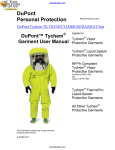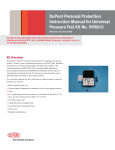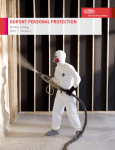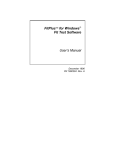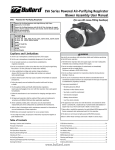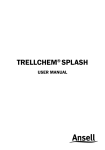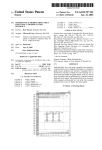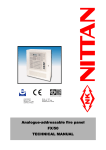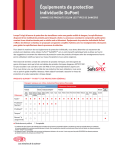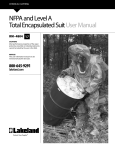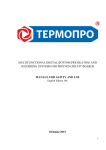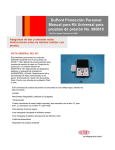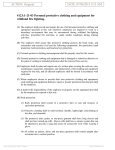Download DuPont Personal Protection
Transcript
DuPont Personal Protection ® DuPont™ Tychem Garment User Manual Revised June 2007 Applies to: Tychem® Vapor Protective Garments Tychem® Liquid Splash Protective Garments NFPA Compliant Tychem® Vapor Protective Garments Certified to NFPA 1991 (2005 Edition) and Class 2, NFPA 1994 (2007 Edition) Tychem® ThermoPro Liquid-Splash Protective Garments Certified to NFPA 1992, (2005 Edition) and NFPA 2112 (2007 Edition) All Other Tychem® Protective Garments This information packet may not be removed except by the end user K-17014 Rev. 6/07 Table of Contents Safety Considerations .............................................................................. 3 Wearer Qualifications ............................................................................... 3 Required and Additional Equipment .................................................... 4 Garment Maintenance Schedule............................................................ 7 Closure Lubricants .................................................................................... 7 Garment Inspection................................................................................... 7 Pressure Testing Level A, Vapor-Protective Garments .................. 9 Repairing Garment .................................................................................. 10 Glove Replacement ................................................................................. 10 Duration of Recommended Use........................................................... 11 Storage Conditions.................................................................................. 11 Visor Antifog Procedures ...................................................................... 11 Marking Suggestions and Restrictions ............................................. 12 Suggested Undergarments ................................................................... 12 Sizing Considerations ............................................................................ 12 Donning the Garment.............................................................................. 13 Doffing the Garment................................................................................ 16 Decontamination and Cleaning............................................................ 17 Garment Retirement Considerations.................................................. 19 Disposal...................................................................................................... 20 Usage Guidance ....................................................................................... 20 Warnings .................................................................................................... 25 Your Responsibility as a User.............................................................. 26 Warranty & Disclaimers ......................................................................... 27 DuPont™ Tychem® Encapsulating Garment Sizing....................... 29 DuPont™ Tychem® Non-Encapsulating Garment Sizing.............. 30 Garment Inspection & Test Log ........................................................... 31 2 Safety Considerations Be sure to read, understand and follow the information in this manual and all applicable federal, state and local occupation safety and health statutes. Serious injury or death may occur from improper use of these garments. Proper use must be consistent with NFPA 1500, Standard on Fire Department Occupational Safety and Health Program, and 29 CFR 1910.132. While wearing any Tychem® garment, including Tychem® ThermoPro, you should not knowingly enter an environment in which the concentration of flammable gas is within flammable or explosive limits. If you determine that you are in such an environment while wearing any Tychem® garments, including Tychem® ThermoPro, then you should immediately retreat. Tychem® garments will not protect you in all situations and environments or protect you from all hazardous materials. You must be a trained and qualified safety professional to select chemical protective clothing. It is your responsibility as a user of this garment to determine the level of exposure and the proper personal protective equipment needed. Most performance properties cannot be tested by the users in the field. Refer to the DuPont™ Tychem® Permeation Guide for chemicals specific to your situation. If any of the following symptoms develop while you are wearing a Tychem® garment, immediately leave the contaminated area, undergo field decontamination, and remove (doff) the garment: - Fever Difficulty breathing Nausea Excessive Tiredness Dizziness Numbness - Any unusual odor or taste Eye or skin irritation Narrowing or dimming of vision Claustrophobia Loss of balance or orientation Wearer Qualifications You should not wear these garments unless you are properly trained in their usage. You must be in good physical condition to wear these garments. Consult a physician before donning one of these garments to ensure you are capable of wearing these garments under the expected work conditions and environment. 3 Required and Additional Equipment To help protect you while wearing this garment and to ensure that the garment performs as intended, you should wear, at a minimum, several additional items of personal protective equipment. Encapsulating garments completely cover you from head to toe, including all respiratory equipment. Encapsulating garments require supplied fresh air; there is not enough fresh air inside encapsulating garments for you to breathe. By design, the replenishment of fresh air is restricted within an encapsulating garment Encapsulating garments that pass the inflation test described in ASTM F 1052, Standard Test Method for Pressure Testing Vapor Protective Ensembles are considered Level A; encapsulating garments that are not designed to pass this test are considered Level B. At a minimum, you should wear the following additional personal protective equipment with an encapsulating and non-encapsulating Tychem® garment: RESPIRATORS • You must wear a full face, supplied air respirator with encapsulating (Level A or Level B) Tychem® garments. 1. An open circuit, self-contained breathing apparatus (SCBA) which is also certified as compliant with NFPA 1981 Standard on OpenCircuit Self-Contained Breathing Apparatus for Fire Service, or 2. An external, breathing air-quality, air-line system with garment pass-through and escape bottle. • You should not wear a closed-circuit (rebreather-type), SCBA with Level A or encapsulating Level B garments. The oxygen concentration inside the suit will rise above normal levels. The final oxygen concentration will depend on the type of closed-circuit respirator you are wearing, your level of exertion and the how long you wear the garment. • You cannot wear an air-purifying respirator (APR) inside a Level A garment nor inside a Level B encapsulating garments nor under separate hoods that extend below the clavicle. • A powered, air-purifying respirator (PAPR) will not work inside an encapsulating garment. (If you breach the garment to expose the PAPR filters to the outside, the garment is no longer considered to be encapsulating.) • You can wear a PAPR under a separate hood, if the configuration provides adequate ventilation at the intake of the unit and if the unit is adequately protected from contamination. 4 OVERCOVERS • NFPA 1991 compliant Tychem® TK and Tychem® Responder® ensembles must be worn with a separate overcover to achieve abrasion resistance, puncture resistance, and protection from direct flame impingement requirements of that standard. You should consider wearing an overcover over other encapsulating garments when there is a risk of abrasion, puncture, cut, tear or direct flame impingement to the garment FOOTWEAR • Separate, user-supplied, protective footwear. The socks attached to some Tychem® garments must be worn inside protective outer footwear. These socks are not suitable as outer footwear. You must wear the separate, user-supplied protective footwear specified in the Technical Data Package when you wear a NFPA 1991, NFPA 1992 or NFPA 1994 compliant garment. • Do not rely on adhesive tape around the top of the boot to prevent liquid pooling inside your boot when wearing a garment with socks and no boot top covers. Adhesive tape does not provide a leak-proof seal. Taping should only be used to hold the leg of the garment in position with regards to the boot. If a leak-proof seal is required, then garments with attached socks and boot top covers should be selected. • When wearing a garment without attached socks, you can reduce the potential for liquid pooling in the boot by wearing the leg of the garment over the top of the chemical protective boot. GLOVES • Chemical protective gloves are attached to your NFPA 1991 and NFPA 1994 compliant Tychem® garments. NFPA compliant garments use two chemical resistant gloves to achieve the chemical barrier requirements of the standard. Removal of one of the glove layers may compromise chemical barrier or glove durability. NFPA 1991 garments also required a separate outer knit glove for cut protection. • If gloves are not attached to the garment sleeve, user-supplied chemical protective gloves should be worn with the sleeve of the garment over the gauntlet of the glove. Adhesive taping of the glove to sleeve interface does not provide a leak-proof seal. Taping should only be used to hold the sleeve in position over the glove gauntlet. If a leak-proof seal between the glove and sleeve is required, then a garment with attached gloves should be selected. • The separate, cut resistant outer gloves that come with your NFPA 1991 are required to meet the cut performance requirements of that standard. 5 With other garments, you should consider similar, cut-resistant outer gloves when you need a high level of cut protection. • When wearing Tychem® ThermoPro, you should wear outer gloves suitable for thermal protection, such as those compliant with NFPA 1971 or NFPA 1951. For additional chemical protection, chemical barrier gloves, such as Ansell Barrier® or North Silver Shield® can be worn under the thermal protective gloves and over inner cotton or knit KEVLAR® gloves. • It is your responsibility to verify that the gloves will provide adequate physical protection and chemical barrier. HEAD PROTECTION • It is your responsibility to determine if you need separate head protection. OTHER PERSONAL PROTECTIVE EQUIPMENT You may also need other personal protective equipment based on the hazard assessment and PPE selection made by a trained and experienced safety professional. Some examples include: • You may require hearing protection due to high levels of external noise or high noise levels generated by supplied air systems. You may require additional protective equipment to deal with hazards created by, but no limited to, the following conditions: - Flammable or Explosive Environment Decontamination Extreme Heat (Heat Stress) Extreme Cold (Hypothermia) Asphyxiating Atmosphere Physical Hazards (Sharps, Puncture, Rough Surfaces, Falling Debris) Slipping or falling Visibility - of wearer & by wearer Communications 6 Garment Maintenance Schedule Work to Be Performed Prior to Use Interval After each Annually use Every 2 years X Check by Wearer Cleaning X Garment Inspection X X Inflation Test (Level A) X X X X Exhaust Valve Diaphragm Inspection (Level A) Exhaust Valve Diaphragm Replacement (Level A) X As required Closure Lubrication Closure Lubricants You can lubricate a zipper or closure that is difficult to operate. You should apply paraffin wax or YKK Zippy Cool Lubricant lightly on the teeth of the closure. After lubrication, the zipper should be closed and opened a number of times to ensure smooth function and to remove excess lubricant. NOTE: EXCESSIVE FORCE OR IMPROPER TECHNIQUE CAN DAMAGE THE GAS-TIGHT ZIPPERS IN LEVEL A SUITS. When opening or closing the zipper, use one hand to hold the zipper assembly near the slider while pulling the slider in a direction that is parallel, close to and along the line of the zipper assembly. Excessive force and not pulling the slider in line with the zipper can lead to permanent damage to the zipper. Garment Inspection (applies to all categories of Tychem® garments) Tychem® Garment Inspection You must inspect all Tychem® garments at the following times: 1. Upon receipt from supplier 2. Before it is worn 7 3. Before the garment is worn again. Contaminated, damaged or altered garments should not be re-used. 4. Annually. Garment inspection ensures that the integrity of the garment has been maintained. You should perform the first inspection as soon as you receive the garment. This ensures that no damage occurred during shipping. You should inspect your garment before wearing, especially if the garment has been worn before. You should not use contaminated, damaged or altered Tychem® garments. You should inspect stored garments once a year. Follow these steps with inspecting garments: 1. Lay the garment on a clean, smooth surface. 2. Use a flashlight inside and examine the outside of the garment for holes, cuts, or tears. Note: Apparent stitch holes covered by seam sealing tape do not constitute a defect. 3. Examine the seam tape for lifts or inadequate seal. 4. Examine the garment material and seams for signs of damage. Fabrics and seams sometimes have visual blemishes that do not affect barrier performance. Such blemishes can include dullness or white frosted areas adjacent to the seam tape. A breach or rupture of the barrier film is cause for rejection. Tincture of Iodine is used to confirm a physical breach. Apply Tincture of Iodine to the suspect area and wipe off the excess with a dry towel. If a dark brown stain remains, the barrier layer has been breached and the garment should be rejected. Areas immediately adjacent to the seam tape may take a slight yellow stain as a result of heat exposure during manufacture. This slight yellow stain is not an indication of a breach. The edges of the seam tape may also develop a thin, but prominent staining of the exposed edge. This is also not an indication of a defect. 5. Examine the visor (if present) for a tight seal and make sure the visor offers clear vision. 6. Examine the garment air distribution system (if present) to make sure that it is connected properly and appears to be in working order. 7. Examine the garment gloves (if present) to make sure they are in good working order. 8. Examine the interface between the gloves and the garment if gloves are attached to the garment. 9. Examine the interface between the socks and the garment if the socks are attached to the garment. 8 10. Examine the garment zipper and zipper cover to make sure they are in good working order. Lubricate the zipper using a small amount of paraffin wax or lubricant supplied by the closure manufacturer. 11. Examine all garment snaps, closures, adjustment straps, pass-thrus and options to make sure they are not obstructed and are in good working order. 12. Examine garment-warning label(s) to make sure they are firmly attached and can be read easily. 13. Level A garments should be subjected to an inflation test during each garment inspection. As part of the inflation test, the exhaust vavle diaphragms must be removed. These exhaust valve diaphragms should be replaced every two years from the date of suit manufacture. Outside this schedule visually inspect the exhaust valve diaphragms. Use a magnifying glass to look for cracks or deterioration. Damaged or deteriorated diaphragms should be replaced. Instructions for replacing the exhaust valve diaphragm can be found in the DuPont Personal Protection Instruction Manual for Universal Pressure Test Kit. Pressure Testing Level A, Vapor-Protective Garments The air-inflation test evaluates the integrity of the Tychem® Level A, vaporprotective garments. DuPont manufactured Tychem® TK, Tychem® BR and Tychem® LV Level A garments are equipped with Auer exhaust valves. Auer valves are fitted with a flexible outer “snorkel” cover that opens at right angles to the throat of the exhaust valve. Tychem® Responder® and Tychem® Reflector® garments are fitted with Pirelli valves. These valves are fitted with a rigid outer cover that is perforated with small holes. Auer Exhaust Valve Pirelli Exhaust Valve You should conduct inflation tests according to ASTM F1052, “Standard Test Method for Pressure Testing Vapor Protective Ensembles”. A copy of the 9 standard may be obtained for a fee from ASTM (www.ASTM.org) or by calling (610) 832-9585. You should read, understand and follow the instructions in the Instruction Manual for the Universal Pressure Test Kit when inflation testing Tychem® Level A garments. You can obtain a copy of these instructions by calling DuPont Personal Protection Customer Service at 800-931-3456 or from our website http://www.personalprotection.dupont.com. You should record the results of each inflation test with the log sheet provided with your garment. You can also find a blank log at the end of this document. The diaphragm in each exhaust valve must be replaced by the end user every two years from date of manufacture. Instructions on purchasing replacement exhaust valve diaphragms can be found on-line at www.personalprotection.com or by contacting DuPont Customer Service at 800-931-3456. Instructions for replacing the exhaust valve diaphragm can be found in the DuPont Personal Protection Instruction Manual for Universal Pressure Test Kit. Repairing Garment You should not use a damaged, altered or contaminated garment. If an uncontaminated or unaltered garment fails a visual inspection or pressure test, contact your safety equipment distributor or DuPont Personal Protection at 800931-3456 to determine if the garment can be returned for inspection or repair. Note: Charges may be incurred. Contaminated garments will not be accepted for repair. Do not send a garment that is discolored or smells. With each returned garment, you must provide the garment testing log and a declaration that the garment has not been exposed to chemicals or to biological pathogens. DO NOT ATTEMPT TO RETURN A GARMENT WITHOUT AUTHORIZATION FROM DUPONT PERSONAL PROTECTION CUSTOMER SERVICE. Glove Replacement Contact DuPont Personal Protection at 800-931-3456 to determine if the attached gloves on your garment can be replaced. 10 Duration of Recommended Use Tychem® garments may be used as long as they pass a full visual inspection. In addition to the visual inspection, Level A garments must pass the ASTM F1052 inflation test. All DuPont™ Tychem® chemical protective garments may contain materials, including gloves and closures for which there is no specific storage life data available. It is suggested that garments be labeled and retired to “Training Use Only” after 5 years after receipt by the purchaser. The diaphragm in each exhaust valve must be replaced by the end user every two years from date of manufacture. Instructions on purchasing replacement exhaust valve diaphragms can be found on-line at www.personalprotection.com or by contacting DuPont Customer Service at 800-931-3456. Instructions for replacing the exhaust valve diaphragm can be found in the DuPont Personal Protection Instruction Manual for Universal Pressure Test Kit. Uncontaminated garments that do not pass a visual inspection should be retired and labeled “For Training Use Only” or be discarded. This includes Level A garments that do not pass the inflation test. Storage Conditions You should store Tychem® garments in a cool, dark, dry location free of dirt and insects. Sunlight, ozone, high temperatures (>120° F), vehicle exhaust fumes, compression under heavy weights and sharp edges or projections are some conditions known to degrade the materials in these ensembles. You should store Tychem® garments in boxes, in bags or on hangers. Never step on chemical protective garments. Never place or store heavy objects on top of chemical garments. Visor Antifog Procedures Antifog treatments can be applied to the interior of Tychem® garment visors. Use antifog wipes or sprays recommended by DuPont Personal Protection. 1. Apply the antifog/anti-static cleaner to a clean, dry cloth or open the prepackaged antifog wipe and unfold it. 2. Apply the antifog solution evenly to interior visor surface. 3. Buff to a clear finish with soft cloth. 11 Marking Suggestions and Restrictions Tychem® garments can be marked with a permanent, felt tip marker. Suggested Undergarments Thick, bulky clothing worn underneath Tychem® garments will affect the fit of the garment and limit the movement of the wearer. You may require a larger size Tychem® garment. You will not reduce your potential for burn injury by wearing garments made of NOMEX® or any other flame-resistant fabric, under Tychem® garments, other than Tychem® ThermoPro. Tychem® garments, other than Tychem® ThermoPro, will burn and possibly melt when exposed to a flash-fire. Only wear non-melting materials under Tychem® ThermoPro garments. These could include NOMEX® or other non-melting fabrics such as wool, cotton, silk and rayon. Sizing Considerations You should verify the size of your Tychem® garment before actual use. Start with the sizing chart found at the end of this document. Verify the size selection with a garment of the recommended size and style you intend to use. Don the garment and perform a series of exercises to simulate your movements under actual work conditions. A garment one size larger or smaller than recommended in the table may be required. However, a garment that is too large is as unsatisfactory as a garment that is too small. These sizing tests should include outer boots, head protection and other accessories the wearer may carry during actual use. Such exercises may include: - read the SCBA gauge - pick up a box, carry it and set the box down in a separate location - pick up a wrench from the ground - open the garment closure - climb up and down stairs and ladder - adjust respirator face piece straps - remove the SCBA without dislodging the full face respirator - remove and refit full face respirator 12 - send and receive radio transmissions - communicate with co-worker wearing the same type of garment and additional equipment - For encapsulating garments, remove hand, wipe faceshield and adjust regulator on facepiece. Donning the Garment You can obtain a donning/doffing training video (H-96428) or DVD (H-96425) by calling DuPont Personal Protection Customer Service at 800-931-3456. You should have a second person present when donning or doffing your chemical protective ensemble. If you are outdoors, you should use a ground cloth to avoid damaging your garment. You should use a stable chair, bench or stool which is free of sharp edges. Encapsulating Level A and B Garments 1. Conduct a visual inspection of the garment before you begin donning: - garment should be free of discoloration or physical damage - inner gloves should be fully inserted into outer gloves - Inside and outside of exhaust valves should be free of caps, plugs or foam padding. 2. Remove all jewelry and personal items (pens, key rings, badges, pagers, knife cases, etc.) that might damage the garment. 3. Check function of respirator and place near donning location. 4. Visually check size and condition of outer boots and place them nearby. 5. Open garment closure completely. 6. Read garment size label to assure proper fit. 7. Apply antifog to inside of visor. 8. Remove your shoes. If the garment has socks, these socks are worn inside additional outer chemical boots. These socks do not have adequate durability or slip resistance to be worn as the outer footwear covering. 9. While sitting, insert your feet into the garment legs and down into socks, if so equipped. Stretch out your legs to maximum extension while pulling garment up around hips. If the garment is fitted with boot top covers, pull 13 boot top covers up and don outer boots. Then pull the boot top covers down over the boots as far as possible. 10. While standing, connect and adjust the garment waist belt (if equipped) until comfortably snug. 11. While standing, with garment at waist level, don your respirator back piece. 12. Don your respirator facepiece and check its function. To conserve SCBA air supply, disconnect the air supply from the facepiece, as long as the closure is open and you have access to fresh air. In the case of an airline breathing system, complete all other connections and adjustments. 13. Don protective headgear and communication equipment. 14. Connect the respirator facepiece to the air supply and make sure the respirator is functioning properly. 15. Place one hand in the sleeve and pull the garment sleeve to your shoulder. Make sure your hand is securely inside the glove, if attached. 16. Place your other hand in the sleeve and into the glove, if attached, and pull the garment over that shoulder. 17. If gloves are not attached to the garment, then don your gloves. Pull the sleeves of the garment over the gauntlet of the gloves. Do not rely upon taping to provide a liquid-tight seal. Taping should only be used to hold the sleeve in position over the glove gauntlet. If a leak-proof seal between the glove and sleeve is required, then you should wear a garment with attached gloves. 18. Pull the garment over the respirator backpack making sure nothing will constrict or hamper airflow. 19. Have your assistant slowly close the zipper. Then your assistant should carefully close and secure the flaps over the zipper. Donning Non-Encapsulating Garments 1. Conduct a visual inspection of the garment before you begin donning: - garment should be free of discoloration, alterations or physical damage - inner gloves should be fully inserted into outer gloves 2. Remove all jewelry and personal items (pens, key rings, badges, pagers, knife cases, etc.) that might damage the garment. 3. Check function of respirator and place nearby donning location. 14 4. Visually check size and condition of outer boots and place nearby. 5. Open the garment closure completely. 6. Read the garment size label to assure proper fit. 7. Apply antifog to inside of visor, if present. 8. Remove your shoes. If the garment has attached socks, these socks are worn inside outer chemical boots. These socks do not have adequate durability or slip resistance to be worn as the outer footwear covering. 9. While sitting, insert your feet into the garment legs and down into socks, if so equipped. Stretch your legs out to maximum extension while pulling garment up around hips. 10. If the garment has outer boot top covers, pull the boot top covers up and don outer boots. Then pull boot top cover down over boots as far as possible. If the garment does not have socks, pull the garment cuff up before donning the boot, then pull the cuff down over the outside of the boot. 11. Place one hand in the sleeve and pull the garment sleeve to your shoulder. Make sure your hand is securely inside the glove, if attached. 12. Place your other hand in the sleeve and glove, if attached, and pull the garment over that shoulder. 13. If gloves are not attached to the garment, don the gloves. Pull the sleeves of the garment over the gauntlet of the gloves. Do not rely upon taping to provide a liquid-tight seal. Taping should only be used to hold the sleeve in position over the glove gauntlet. If a leak-proof seal between the glove and sleeve is required, then you should wear a garment with attached gloves. 14. Don your respirator facepiece and check its function. If using an SCBA, disconnect the air supply from the facepiece, if possible, to save air supply. 15. Don protective headgear, if it is worn underneath the garment hood, and communication equipment. 16. Place the attached hood, if present, over your head and close the zipper. 17. After checking that the zipper is completely closed, fold and secure the flaps over the closure. 18. In the case of an air-line breathing system, complete all connections and adjustments. 15 19. Connect your respirator facepiece to the air supply and make sure the respirator is functioning properly. 20. If applicable, place the separate hood over your head and attach the underarm straps. Doffing the Garment Encapsulating Garments 1. If your garment has been contaminated or is suspected of being contaminated, you must first undergo field decontamination. 2. Continue to use your respirator until the garment has been doffed and removed. 3. An assistant should help you doff the garment after field decontamination. If the garment has been contaminated, your assistant should wear protective clothing and respiratory equipment. 4. While standing, have your assistant open the zipper and peel the garment down and away from your shoulders. The assistant should help you remove your arms from the sleeves. External air lines should be disconnected from the garment, while you switch to your escape bottle. 5. Lower garment below your hips and sit down. Do not touch the inside of the garment. Your assistant should remove your boots, pull the garment off your legs and take the garment away. 6. Once the garment has been removed, you can doff the respirator facepiece and harness. Non-Encapsulating Garments 1. If your garment has been contaminated or is suspected of being contaminated, you must first undergo field decontamination. 2. After field decontamination, if the garment has been contaminated or is suspected of being contaminated, you should continue to use your respirator until the garment has been doffed and removed. 3. An assistant should help you doff the garment after field decontamination. If your garment has been contaminated, your assistant should wear protective clothing and respiratory equipment. 4. Remove and discard the separate outer hood if present. 16 5. If you are wearing an SCBA or PAPR, your assistant should help you remove the backpack or filter unit without disconnecting the facepiece. The tank or filter unit should either be held by another person or placed in a dry, secure position. While you stand, your assistant should partially open the closure of your garment, pull down the hood, open the closure completely and peel the garment down and away from your shoulders. The assistant should help you remove your arms from the sleeves. 6. You assistant should lower the garment below your the hips without touching the inside of the garment. 7. While sitting, your assistant should help you remove your boots, pull the garment off your legs and take the garment away. 8. Once the garment has been removed, you can disconnect and remove the respiratory facepiece. Decontamination and Cleaning DuPont Tychem® garments are designed for limited-use applications – they can be worn until damaged, altered or contaminated. If the garment is contaminated during use, it must be discarded. If the garment is damaged during use, retreat immediately, undergo field decontamination, and then discard the garment. It is the responsibility of the safety professional having responsibility over usage of the garment to determine whether the suit has been contaminated or be safely re-used. Soiled Garments You can clean garments that are soiled but not contaminated with hazardous substances. You should use water, mild dishwashing liquid, a soft brush and hand towel to remove the dirt. Then thoroughly rinse the garments with clean, fresh water and air-dried. Do not dry-clean or machine-wash these garments. Do not use hot air or a tumbling air dryer to dry these garments. Do not use bleach on these garments it they are intended to be re-used. Thoroughly inspect a cleaned garment before re-use following the instructions provided in manual. Do not re-use the garment if it fails the inspection or shows sign of alteration, damage or contamination. Field Decontamination The purpose of field decontamination is to allow you to doff the garment without being harmed by contaminants on the garment surface. Field decontamination 17 does not make a garment safe for re-use. If you suspect or know that a garment has been contaminated, if must be discarded after field decontamination. If you know or suspect that a garments has been contaminated with hazardous radioactive or chemical materials: . Use water and mild dishwashing liquid to field decontaminate the garments prior to doffing. Do not use oxidative, corrosive or reactive decontamination solutions to remove known or suspected chemical or radioactive contaminants. You must discard the garment after field decontamination. Do not use a garment that has been chemically or radioactively contaminated for training. If you know or suspect that a garments has been contaminated with a hazardous biological toxin or pathogen: You can use water and mild dishwashing soap or you can use liquid biological disinfectants. You must mix and apply the disinfectant according to the recommendations of the manufacturer of the disinfectant. Remove residue disinfectant by cleaning the garment with water and household dishwashing liquid before doffing. You must determine if the disinfectant will degrade the performance of the garment materials. You must discard garments suspected or known to have been biologically contaminated. You must discard garment that have treated with biological disinfectants. You must not use a garment that has been biologically contaminated for training. The steps of field decontamination are: 1. Leave the hot zone with adequate air supply for field decontamination and removal of the garment. Continue to wear the respirator until you completely doff the garment and it is removed from your presence. 2. For incidents involving biological hazards, the outside of the garments can be decontaminated with active peroxide or chloride liquid disinfectants mixed and applied according to the disinfectant manufacturer’s instructions. Thoroughly rinse the disinfectants off the garment. Then the garment should be washed with water and 18 household dishwashing liquid before doffing. Garments subjected to biological decontamination are contaminated and must be discarded. 3. If the garment has been chemically exposed or is suspected to have been exposed, thoroughly clean the garment using household dishwashing liquid and soft brushes, followed by a thorough rinsing in water. A garment with known or suspected chemical contamination should not be re-used. 4. If possible, remove the excess rinse water from the garment before doffing. This should only be done by trained personnel wearing gloves, liquid-splash protective clothing and respiratory protection. At a minimum, the rinse water on and near the garment closure assembly must be absorbed before opening the closure. Inspection before Re-use Field decontamination does not make a garment safe to re-use. Garments previously contaminated with hazardous chemical, biological or radioactive materials must not be re-used or used in training; they must be discarded. Garments treated with disinfectants are chemically contaminated and should not be re-used. Before an uncontaminated garment can be re-used, hygienically clean, visually inspect and in the case of Level A garments, conduct an inflation test. Garment Retirement Considerations Tychem® garments should be retired from service if any of the following criteria are met: • Garment fails to pass inspection. • Vapor-protective garment fails the inflation test. • Garment is altered, abraded, cut, torn, punctured, or otherwise, and in any way, breached. • Garment has had prolonged exposure to intense heat and/or ultraviolet light. • Garment has been contaminated which is determined by responsible enduser knowledge of use and exposure. • Garment has been decontaminated with an oxidative, corrosive or reactive decontamination agent. 19 Retired garments that are not contaminated may be labeled and used “For Training Only”. The labeling should be done with a permanent marker. Disposal If not contaminated, Tychem® garments may be buried or incinerated. Uncontaminated chemical protective garments may be incinerated in a facility that is capable of handling mixtures containing plastics. Likewise, an uncontaminated chemical protective garment may be buried in a facility that accepts plastic materials. Tychem® garments contain several different plastics; they are not suitable for recycling. Contaminated garments that cannot be handled safely without protective equipment should be disposed of with other hazardous wastes, either through incineration or burial. Before discarding, garments should be mutilated by cutting off a sleeve or a leg so they cannot be worn again. Usage Guidance Required Equipment All DuPont™ Tychem® garments must be worn with additional personal protective equipment described in the “Required and Additional Equipment” section of this guide. Respirators Most Tychem® garments are worn concurrently with respirators. You must be fit and trained to use a respirator. The performance of your protective respirator must be verified with a performance based fit test. Failure to properly select, test, use and maintain your respirator can result in serious injury or death. Temperature Range Tychem® garments can be used in an ambient environment from -31° F (-25° C) to 190° F (90° C). Tychem® garments do not provide protection at high ambient temperatures. Tychem® garments should not be stored at temperatures exceeding 120° C. Limitations of Use 20 No Tychem® garment has been tested or validated for protection against ionizing radiation. No Tychem® garment has been tested or validated for protection from cryogenic liquids and gases, which is defined as colder than -328° F (200° C). If there is a risk of exposure to liquefied gases warmer than -148°F (-100° C), then consider the use of a DuPont™ Tychem® TK ensemble certified to the optional liquefied gas requirements of NFPA 1991 (2005 edition). Tychem® fabrics offer little or no thermal insulation to protect the wearer's skin from prolonged exposure to hot or cold. The temperature range for the fabric and seams is well beyond the temperatures that the human skin can withstand without injury. If the danger of exposure to biological aerosols or chemical warfare chemicals exists, the use of a protective ensemble certified to NFPA 1991 (2005 Edition) or to NFPA 1994 (2007 Edition) should be considered. No Tychem® garment is intended for fire fighting activities, nor for protection from hot liquids, steam, molten metals, welding, electrical arc, flammable atmospheres, explosive environments or thermal radiation. You should mitigate the risks of flash fire by substitution, engineering controls, work practices and administrative controls in addition to PPE. Direct exposure of personnel should be minimized or avoided. At a minimum, fire-suppression equipment and personnel should be ready and manned to conduct fire suppression should a flash fire occur. You should not knowingly enter a flammable or explosive environment while wearing a Tychem® garment, including Tychem® ThermoPro. Should you determine that the environment you are in is potentially flammable or explosive, you should retreat immediately, including when wearing Tychem® ThermoPro. Tychem® garments are not suitable in all situations and environments or with all chemical and hazardous materials. All decisions regarding the selection and use of chemical protective clothing must be done by trained and qualified safety professionals. It is the user’s responsibility to determine the level of exposure and the proper personal protective equipment needed. No Tychem® garment, including Tychem® ThermoPro is suitable for use in situations of elevated oxygen concentrations. This includes spills involving liquid oxygen. Always Use the Buddy System Never enter a contaminated area alone. A minimum of two people should enter contaminated areas together with two additional people, in equally protective garments available to affect rescue of the entry team. You Must Be Physically Fit 21 You must be physically fit to wear a Tychem® garment. You should be examined by a physician to see if you are sufficiently fit to wear a chemical protective garment. Manage and Prevent Heat Stress Chemical protective clothing interferes with the natural regulation of body temperature. This can lead to a rise in core body temperature and heat stress. You can take several steps to limit and/or prevent heat stress, such as the use of a cooling system, and implementing a conservative work/rest schedule. You should be aware of the symptoms and treatment of heat stress. If you or your co-workers have symptoms of heat stress such as nausea, dizziness, high heart rates, or excessive heat build-up, you should leave the work area immediately and remove the ensemble as quickly as possible after decontamination and seek professional care. The maximum time the ensemble can be worn depends on such variables as the air supply, ambient condition, climate inside the ensemble, physical and psychological condition of the wearer, work rate and work load. The TLV™ pocket guide from the American Conference of Governmental Industrial Hygienists (ACGIH, Cincinnati) provides corrected heat stress limits for some garments. Similar information is available on the federal OSHA web site (www.OSHA.gov). The WBGT correction factor for chemical protective garments is at least 10° C or higher for chemical garments made of impervious film and covering the entire body (hooded coverall or encapsulating designs). Chemical Permeation Data Before using a protective ensemble in a chemical situation, consult the chemical permeation data appropriate to the garment material. Note that seams, visors and closures will generally have lower or different permeation times than the garments’ material. This information is to be used as a guide only. The permeation performance of any material depends on a number of factors including chemical concentration, temperature, time and amount of exposure. Due to the large number of variables, it is impossible for all ensemble materials to be tested against all chemicals, all combinations or mixtures, and all temperatures at which the chemical might be encountered. Chemical permeation tests are performed under laboratory conditions -- not actual workplace conditions. They address chemical breakthrough characteristics and do not account for physical performance characteristics that affect a barrier such as abrasion, flex fatigue, puncture, tear, oxidative degradation, or degraded performance due to previous contamination. No single protective material will protect against all chemicals for all situations. The best course of action is to test the primary protective garment materials against the specific chemical hazard, at the temperature and in the 22 concentrations to be encountered. DuPont will provide free swatches of primary garment materials for testing and can provide you with a list of testing facilities. Static Electricity Under certain conditions, such as cold and dry weather, it is possible that garments might build and discharge static electricity. Discharges are not normally dangerous except in situations where the generation of an electrical spark could ignite a flammable atmosphere or startle the wearer. When operating around flammable chemicals, take steps to eliminate potential static discharges. In these situations, recommended steps include, but not limited to, water spray, the use of an overcover, raising humidity level of the work area, use of a commercial, anti-static application coating, grounding straps on equipment and personnel, inherently static-dissipating under- and over-garments, and testing of the worker’s static dissipation before entry into the classified area. However, in the case of explosive or flammable atmospheres, even if sophisticated and elaborate steps are taken to manage static formation and dissipate static charge, the risk of severe injury remains if an uncontrolled or accidental ignition occurs. You should not wear Tychem® chemical protective garments in potentially flammable or explosive atmospheres. You should not knowingly enter an environment in which the concentration of flammable gas is within flammable or explosive limits while wearing a Tychem® garment, including Tychem® ThermoPro. Should you determine that you are in a potentially flammable or explosive environment while wearing a Tychem® garment, including Tychem® ThermoPro, you should retreat immediately. Avoid Exothermic Reactions Certain chemicals produce a large amount of heat when they react with water. If your garment is heavily contaminated with a water-reactive chemical, there is a possibility that the garment may be damaged during field decontamination from the high reactive heat. The excess chemical should be removed with dry sand or non-reactive absorbent before water decontamination. Avoid Continuous Exposure Tychem® garments should not be immersed in chemicals. These garments should not be exposed to continuous hazardous liquid chemical splash or deluge. Do not wade through liquid pools of hazardous chemicals if it is not necessary. Direct, liquid chemical exposure to the ensemble should be as limited as possible. If exposed to direct splash or a deluge of hazardous chemicals, leave the area immediately and decontaminate. Supplied Air Line Applications To connect to an external supplied air-line system, encapsulating garments must be equipped with the appropriate, NIOSH approved garment pass-through. This pass-through connection should not be relied upon as an anchor for a tether. Excess pull on this fitting may result in permanent damage to the garment. 23 Avoid Suffocation Do not attempt to wear an encapsulating, chemical protective garment without a supplied fresh air respirator (SCBA or air-line). Use separate, user-supplied, fullface respiratory protection such as: 1) an open circuit, self-contained breathing apparatus (SCBA) or 2) an external, breathing air quality, air line system with garment pass-through and escape bottle. You should not wear a closed-circuit (rebreather-type), SCBA with Level A or encapsulating Level B garments. The oxygen concentration inside the suit will rise above normal levels. The final oxygen concentration will depend on the type of closed-circuit respirator you are wearing, your level of exertion and the how long you wear the garment. Air-purifying respirators (APR) do not work inside of encapsulating garments – these garments require a source of fresh breathable air. Air-purifying respirators (APR) cannot be worn under separate protective hoods that extend below the clavicle. Powered air-purifying respirators (PAPR) do not work inside of encapsulating garments, whether Level A or Level B. If the garment is breached by the filters of the PAPR, it is not considered an encapsulating garment. PAPR’s can be worn with ensembles utilizing separate hoods, if the configuration provides adequate ventilation at the intake of the unit and the unit is adequately protected from contamination. Never Use Pure Oxygen The use of 100% oxygen in these garments presents serious fire safety and health hazards. Use only breathing quality compressed air or air-line breathing air. You should not wear a closed-circuit (rebreather-type), SCBA with Level A or encapsulating Level B garments. The oxygen concentration inside the suit will rise above normal levels. The final oxygen concentration will depend on the type of closed-circuit respirator you are wearing, your level of exertion and the how long you wear the garment. Attached Socks The socks attached to chemical protective garments are designed to be worn inside outer boots. These socks do not have sufficient durability or slip resistance to be worn as outer boots. Provide Hearing Protection 24 If noise levels inside these garments exceed regulatory noise limits, hearing protection must be provided. Use hearing protection recommended by a safety professional which does not interfere with the operation or use of the garment. Communications A chemical protective garment hampers communication. You should consider using a personal communication system. You can use hand signals to communicate during training, work, and for emergency situations where respirators and chemical protective garments are worn. Positive Pressure Excessive, internal positive pressure can damage these garments. Do not inflate the vapor-protective garments above a pressure of 7 inches water column. Use of Adhesive Tape to Seal Tychem® Garments Adhesive tape cannot provide a completely liquid- or vapor-tight seal. Taping may reduce bulk flow if carefully applied. During an emergency situation it may be difficult to carefully apply tape. Taping should be viewed, primarily, as a means to hold clothing items in place; to hold a hood over the respirator, to hold a sleeve over a glove, to hold a pant leg over a boot, or to hold a closure flap closed. Taping does not provide reliable barrier performance. Limitations of Liquid-Splash Protection Hooded Tychem® garments without visors are not liquid-tight around the hood/respiratory interface. Careful taping may reduce bulk liquid flow around this interface, but should not be relied upon for total barrier. The wrist and ankle openings of garments without attached gloves or socks have similar limitations. Garments with more protective designs should be used in lieu of taping as well as implementation of engineering controls, work practices and administrative controls to reduce the potential for exposure. Warnings Tychem® chemical protective garments, other than Tychem® ThermoPro, will ignite and continue to burn. No Tychem® garment should be worn around heat, open flames, sparks or any other possible ignition source nor in potentially explosive or flammable environments. Wearing garments made of NOMEX® or any other flame-resistant fabric, under Tychem® garments, other than Tychem® ThermoPro, will not reduce burn injury during a flash-fire. Tychem® garments, other than Tychem® ThermoPro, will burn and possibly melt when exposed to a flash-fire; this is likely to increase burn injuries even when worn over garments made of NOMEX® or any other flameresistant fabric. 25 Tychem® garments, other than Tychem® ThermoPro, melt when exposed to heat and flame, these garments should not be worn under a garment made of NOMEX® or any other flame resistant fabric, if the potential for flash-fire exists. You should not knowingly enter an environment in which the concentration of flammable gas is within flammable or explosive limits when wearing a Tychem® garment, including when wearing a Tychem® ThermoPro garments. Should you encounter such an environment while wearing any Tychem® garment, including Tychem® ThermoPro, retreat immediately. No Tychem® garment, including Tychem® ThermoPro, is intended for fire fighting activities, nor for protection from hot liquids, steam, molten metals, welding, electrical arc or thermal radiation. Tychem® ThermoPro garments are designed and tested to help reduce injury during escape from a flash fire. Tychem® garments are not suitable for use when the ambient concentration of oxygen is elevated. Your Responsibility as a User You must be a trained and qualified safety professional to select chemical protective clothing. It is your responsibility as a user of this garment to determine the level of exposure and the proper personal protective equipment needed. It is your responsibility as a user to select garments which are appropriate for each intended use and which meet all specified government and industry standards. Tychem® garments are intended to help reduce the potential for injury, but no protective apparel alone, can eliminate all risk of injury. Protective apparel must be used in conjunction with general safety practices. Tychem® garments are designed for limited use. It is the wearer’s responsibility to inspect garments before use and periodically to ensure that all components, including fabric, valves, visors, gloves, zippers, seams, and interfaces are in good working condition, and provide adequate protection for the operation and chemicals to be encountered. Failure to fully inspect garments may result in serious injury or death to the wearer. Never wear garments that have not been fully inspected and in the case of Level A garments, pressure tested prior to use. Any garment which does not pass inspection should be removed from service immediately. Never wear a garment that is contaminated, altered or damaged. 26 If the Tychem® garment is altered, abraded, cut, torn, punctured or otherwise and in any way breached, do not use. The chemical protective garment material has finite resistance to abrasion, cut, tear and puncture. If the Tychem® garment is damaged during use, retreat immediately to a safe environment, thoroughly decontaminate the garment, then dispose of it in a safe manner. It is the responsibility of the garment wearer, and the wearer’s supervisor and employer to examine the condition of the garment before and during use to be sure that the garment is suitable for use in that environment by that employee. Warranty & Disclaimers DuPont makes no guarantee of results and assumes no obligation or liability in connection with the use of DuPont garments and accessories. It is user’s responsibility to determine the level of hazards and the proper personal protective equipment needed. DuPont warrants to the purchaser/end user only for a period of ninety (90) days from date the garment or accessory was shipped to the purchaser/end user or, for a period of twelve (12) months from the date the encapsulated garment was shipped to the purchaser/enduser that the garment and accessory, if any, are free of defects in materials and workmanship. Since conditions of use are outside DuPont’s control, DUPONT MAKE NO OTHER WARRANTIES OF ANY KIND, EXPRESSED OR IMPLIED, INCLUDING, WITHOUT LIMITATION, NO WARRANTIES OF MERCHANTABILITY OR FITNESS FOR A PARTICULAR USE and assume no liability in connection with any use of the DuPont garment and accessories. This warranty is void in the event any party including purchaser/end user modifies the garment or accessory in any way. The sole and exclusive remedy for all purchasers and/or end users for any and all claims, losses, injuries or damages of any kind relating to or arising from DuPont garments and accessories, shall be the refund of the purchase price or the replacement or repair of any garment or accessory found to contain a defect in materials or workmanship upon inspection by DuPont. Only DuPont shall determine the form of remedy (repair, replacement, or refund) for items containing a defect in materials or workmanship. No warranty claim shall be honored unless received by DuPont within 90 days of the date the garment or accessory was shipped to the purchaser and/or end user or, within twelve (12) months from the date the encapsulated garment was shipped to the purchaser/end user. IN NO EVENT SHALL DUPONT BE LIABLE FOR ANY SPECIAL, INCIDENTAL, INDIRECT, PUNITIVE OR CONSEQUENTIAL DAMAGES, WHETHER ARISING FROM CONTRACT, TORT, WARRANTY, REPRESENTATION, INSTRUCTION, 27 DESIGN OR MANUFACTURING DEFECTS, OR ANY OTHER CAUSE OR THEORY. Product safety information is available upon request. This information corresponds to our current knowledge on the subject. It is offered solely to provide possible suggestions for your own experimentations. It is not intended, however, to substitute for any testing you may need to conduct to determine for yourself the suitability of our products for your particular purposes. It is the user’s responsibility to determine the level of risk and the proper protective equipment needed for the user’s particular purposes. This information may be subject to revision as new knowledge and experience becomes available. Since we cannot anticipate all variations in actual end-use conditions, DUPONT MAKES NO WARRANTIES AND ASSUMES NO LIABILITY IN CONNECTION WITH ANY USE OF THIS INFORMATION. Nothing in this publication is to be considered as a license to operate under or a recommendation to infringe any trademark or patent right. DuPont™, the DuPont oval, The miracles of science®, Tychem®, NOMEX®, KEVLAR® and Responder® are trademarks or registered trademarks of E.I. du Pont de Nemours and Company or its affiliates. TLV™ is a trademark of the American Conference of Governmental Industrial Hygenists (ACGIH, Cincinnati). © Copyright 2007 E.I. du Pont de Nemours and Company, Inc... All rights reserved. E. I. du Pont de Nemours and Company, Inc.., DuPont Personal Protection, P.O. Box 27001, Richmond, VA 23261. 1-800-931-3456 www.personalprotection.dupont.com 28 DuPont™ Tychem® Encapsulating Garment Sizing 29 DuPont™ Tychem® Non-Encapsulating Garment Sizing 30 DuPont™ Tychem® Garment Inspection & Test Log SERIAL # DATE INSPECTOR REMARKS TEST RESULTS 31































